The main purposes of chronic otitis media surgery are to achieve intact tympanic membrane, a middle ear cavity lined with normal mucosa and to improve the hearing. There are two established techniques of myringoplasty, overlay technique and underlay technique. In overlay technique we place the graft lateral to the fibrous layer of the tympanic membrane. In underlay technique we place the graft medial to the tympanic membrane remnant [1].
Underlay technique is the most common and time tested technique, is typically used for posterior perforations, whereas the overlay technique is more technically challenging and particularly suited for anterior large or subtotal perforations [2].
Although overlay technique has higher success rate for the reconstruction of anterior large or subtotal tympanic membrane perforation, it’s more challenging and demands surgeons skill and serious complications including anterior angle blunting, graft lateralization, epithelial pearls and delayed healing may occur [1].
Repairing subtotal or anterior quadrant perforations remains a challenge especially when using underlay technique, perhaps because of inadequate blood supply, lack of residual remnant tympanic membrane to support the graft anteriorly and poor exposure.
This study is carried out to compare the results of circumferential subannular graft technique with conventional underlay technique in achieving greater success with graft uptake, hearing improvement and prevention of complications, in chronic otitis media of mucosal type.
Materials and Methods
This study was conducted in the Department of Otorhinolar-yngology Head and neck surgery, JJM Medical College, Davangere from July 2014 to June 2015, after taking informed consent and required clearance from Ethical Committee. It is a comparative, prospective study in which 50 cases were included where myringoplasty was done. Simple random method is used in dividing the patients into two groups to avoid selection bias and the sample size is calculated using sample size formula.
In this study two different methods of grafting technique were done i.e. 25 cases of conventional underlay technique and for another 25 cases circumferential subannular graft technique was used. Detailed history acquired and thorough clinical and detailed otoscopic examination with all routine investigations and pure tone audiogram was done in all cases.
Inclusion criteria
Chronic otitis media of mucosal type with conductive hearing loss.
15-60 years of age of both the sexes.
Exclusion criteria
Patients having COM of atticoantral type.
Ossicular discontinuity.
Extensive disease requiring exteriorizing procedure like modified radical mastoidectomy.
Patients with previous otologic surgery.
Surgical steps of circumferential subannular grafting technique (Right side)
All patients were operated under general anaesthesia with postaural approach. With postauricular incision, temporalis fascia graft was harvested. A rim of tissue was removed to freshen the perforation margins and undersurface of the remnant tympanic membrane scraped to ensure completely de-epithelialized medial surface of the remnant tympanic membrane. Posterior canal skin was incised 3-4mm medial to spine of Henle. The tympanic membrane flap elevated along with posterior annulus [Table/Fig-1].
Canal skin incision as described in text.
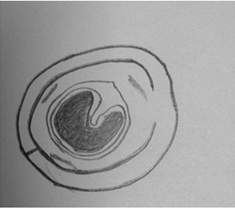
Elevation of the medial part of the tympanic membrane and the annulus continued anteriorly with an anterior flap from 1’0 clock to 4’0 clock position [Table/Fig-2]. Then middle ear was filled with gelfoam, and graft was placed under handle of the malleus and made sure that graft margins lies over the bony canal wall [Table/Fig-3,4]. Tympanic membrane flap was repositioned and the gel foam was kept in the external auditory canal. Postauricular wound was closed and a snugly fitting, mastoid bandage was applied.
Elevation of the medial part of Tympanic membrane and Annulus continued anteriorly with anterior flap from 1’O.4’O clock position.
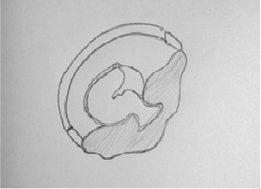
Final placement of the graft.
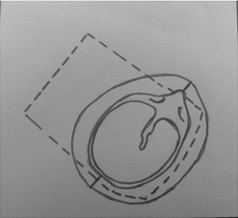
Intraop image of circumferential subannular grafting technique
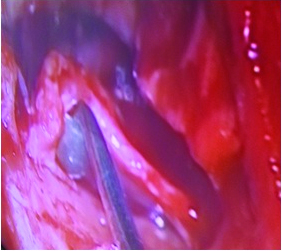
Every patient was examined after three months of postoperative period. Outcome of surgery was regarded as successful if the ear gets dry, the tympanic membrane heals and intact and mobile. Audiometric test is performed according to ISO standard after 3 months of postoperative period.
Preoperative and postoperative hearing threshold, air bone gap was determined by comparing the audiogram. The data was analysed with the help of a paired t-test.
Results
A total of 50 patients were included in this study out of which 21 were males and 29 were females with male to female ratio of 0.72: 1.
Circumferential subannular grafting technique is done for 21 subtotal perforations and 4 large anterior perforations, where as conventional underlay technique is done for 14 subtotal and 11 large anterior perforation of the tympanic membrane. The success rate of graft take up by circumferential subannular grafting technique is 24 (96%) of the 25 patients and by conventional underlay technique is 19 (76%) of the 25 patients respectively [Table/Fig-5].
| Techniques | No. of cases | Success | % | Failure |
|---|
| Circumferential subannular technique | 25 | 24 | 96.0 | 1 |
| Conventional underlay technique | 25 | 19 | 76.0 | 6 |
| Total | 50 | 43 | 86.0 | 7 |
The hearing improvements after 3 months following surgery were studied in the patients with successful outcome. In circumferential subannular grafting technique, the pre-op mean PTA was 36.92db, and the post-op mean PTA after 3months was 25.87 db with a mean difference in PTA (dB) was 11.05 with t-value of 7.74. In case of conventional underlay technique, the pre-op mean PTA was 38.24 db, and the post-op mean PTA after 3 months was 30.28 db with a mean difference in PTA(dB) was 7.96 with t value of 14.39 [Table/Fig-6]. The mobility of the neotympanum at the end of 3 months tested clinically with pneumatic otoscopy [Table/Fig-7].
Improvement in hearing after 3 months with pre and postoperative PTA (db) by two different techniques of myringoplasty
| Techniques | Pre- op mean PTA in db | Post-op mean PTA in db after 3 months | Mean difference in PTA (db) | t-value |
|---|
| Circumferential subannular technique | 36.92 | 25.87 | 11.05 | 7.74 |
| Conventional underlay technique | 38.24 | 30.28 | 7.96 | 14.39 |
Image showing neotympanum after 3 months of postop period
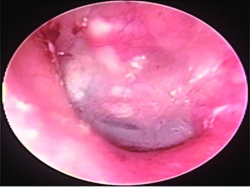
Discussion
Myringoplasty is the operative procedure performed to repair the tympanic membrane perforation and to improve hearing level [3]. The graft success rate depends on various factors such as the size of the perforation, functioning of eustachian tube, graft placement techniques, the experience of the operating surgeon etc. There is marked diversity noted in achieving an intact tympanic membrane following myringoplasty [4].
It is often reported that repair of anterior and subtotal perforation by conventional underlay technique is less successful when compared to small perforation because it is technically more difficult [5]. In the study by Lee et al., the success rate for small perforation was 74.1 % and for large anterior and subtotal perforation was 56 % [6], showing that small perforations have more favourable outcome. To improve the success rates, many surgeons adopted different techniques. Palva introduced his Swing Door Technique to enhance anterior visualisation of the tympanum [7]. Ralli et al., used underlay anchored myringoplasty which utilizes anterior and posterior tunnels to achieve proper tension of the tympanic membrane as well as lateral traction of the malleus handle [8]. It resulted in drum healing (91.7%) and pure tone average (PTA) post operatively was 27dB as compared with 55 dB preoperatively. Primrose and Kerr were able to improve graft tension by using an anterior tunnel created under the annulus [9]. Sauvage et al., presented a surgical technique that included the creation of a large anterior flap for stabilizing the fascia [10].
Farior described elevation of tympanomeatal flap from 12’0 clock to 3’0 clock position [11]. We modified this technique and extended the incision from 12’0 clock to 1’0 clock position, which allows the graft to be anchored under the handle of malleus and to be reposited into the bony annulus, which allows good graft uptake and postoperative hearing gain.
The circumferential subannular grafting technique achieved 96% success rate, when compared to conventional underlay technique where we are able to get only 76% of the result. The similar study was done by F Mokhtarinejad et al., he reported 95% success in graft uptake. Our results and observations are comparable with his study [12].
In our study, circumferential subannular grafting technique achieved 96% success rate which is better than previous study done by Muhammad Rafiq et al., [13] where graft success rate is 88%, mainly because he used conventional underlay technique. Rahul Kawatra showed 87% graft success rate by conventional myringoplasty. Our comparative study also showed better results with subannular circumferential grafting technique than with conventional technique.
The postoperative mean hearing gain (3months) by circumferential subannular technique was 11 dB and by conventional underlay technique was 8 db. This shows more hearing improvement postoperatively by circumferential subannular grafting technique when compared to conventional underlay technique. Good hearing gain in our study can be correlated with expertise technique to deal with subtotal and anterior large perforations with special reference to the circumferential flap, maintaining the conisation of the grafted tympanic membrane by placing the graft under the handle of malleus.
Various surgeons have used different kinds of grafts to repair tympanic membrane perforations. Most popular are autogenous grafts. Zollner (1954) [14] and Frenckner (1955) [15] used pedicled ear canal skin graft to close perforations. Shea (1960) [16] introduced vein graft to close tympanic membrane perforations. It goes to the credit of Heermann (1960) [17] for introducing temporalis fascia as a grafting material in tympanoplasty. We used temporalis fascia graft to close the perforations and could achieve good results both in terms of drum healing (96%) and postoperative hearing improvement.
One case suffered complete rejection by circumferential subannular grafting technique, probably due to infection or poor Eustachian tube function.
Usually we encounter the complications such as anterior blunting, lateralization and medialization of the graft. In our study no complications were seen. We took special care in circumferential subannular grafting technique, by placing the graft under the handle of the malleus and over the bony canal wall and support it with a gel foam medially as well as laterally.
Limitation
The limitations for this study includes extensive tympanosclerosis, congenital fixation of ossicles, chronic necrotizing otitis media and external ear anamolies.
Conclusion
The ultimate aim of tympanic membrane grafting technique is to have new reconstructed tympanic membrane with functions as close as possible to original tympanic membrane and to prevent complications. The circumferential subannular grafting technique is found to be superior to conventional underlay technique in graft uptake rate as well as postoperative hearing improvement. So, we recommend circumferential subannular grafting technique, when the anterior rim of the remnant tympanic membrane is inadequate as in case of subtotal and anterior large perforations for the better results and outcome.